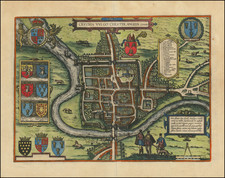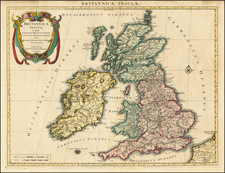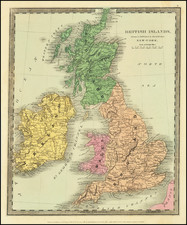Mid-19th Century watercolor map of the Spa, located south of Ballynahinch in County Down, Northern Ireland.
The map depicts the district of Spa near Ballynahinch, which thrived as a popular tourist resort; its main attraction being natural wells that provided water much lauded for its health benefits. Spa has been called "the original health farm."
This work shows Spa at the center, surrounded by numbered guest houses. To the north is the road to Ballynahinch, and to the south, Seaford. Also shown is the adjacent Montalto estate: A largely walled demesne with a mid-18th Century house, featuring a tree ring, specimen trees and exotics around the house, lawns down to a lake, a hedged productive garden and a deer park. On the left of the map is Millvale set high on a hill, where today the windmill ruins can still be seen. Above Millvale is the title, "Ballynahinch Spa," and two flowers with the motto "Fraterna Charitas Meneat." In the bottom left corner is a note of scale, "6 inches to one mile" followed by what we assume are the artist's initials.
The medicinal properties of the water from the three wells at Spa had been touted since the early 18th Century, with many people reporting drinking it had cured them of their ills. At the turn of the century, David Ker saw the commercial possibilities of the Spa, and resolved to use this natural resource to bring prosperity to the town. Ballynahinch and Spa benefited from the start of the tourist revolution of the late 18th Century, and in 1810 Ker installed two pumps at Spa to bring the water to the surface more efficiently. These pumps are still in existence, having been restored by Councillor Harvey Bicker. On the front there is a small brass plate which states that they were imported from Joseph Branagh in London and installed by David Ker. Branagh was a pioneer of the flushing lavatory and the pumps were the latest in cutting edge technology during the regency period.
As the wells' popularity grew, Ker developed accommodation houses (numbered on the map), a Temperance hotel was built (later known as the Spa Hydro Hotel), and leisure amenities were added, including a maze in 1815. The hotel still exists but is now a private home and the maze was sadly bulldozed years ago. In 1840, another member of the Ker family built a ballroom at Spa called the assembly rooms, now known as the Spa road-house. The railway arrived in 1859 bringing tourists from Presbyterian Belfast and in 1873 a new church was built for them at Spa (depicted at the bottom of the map).
The railway station in Newcastle, opened in 1869, caused the popularity of Spa to dwindle as the beach became preferable to the wells. However tourism at Spa continued up to the start of World War II as the resort adapted and catered for the whims of the tourists, providing croquet lawns and building a golf course, which still thrives today.
For more on the Spa wells and Ballynahinch, see this link: www.bbc.co.uk/northernireland/yourplaceandmine/down/bhinch_spa.shtml










![(First World War - Seriocomic) Европа въ 1915 г. [Europe in 1915]](https://storage.googleapis.com/raremaps/img/small/98679.jpg)


![(British Isles) Tabu Moder Anglie & Hiber [Modern Map of England and Ireland]](https://storage.googleapis.com/raremaps/img/small/103164.jpg)
